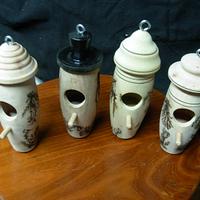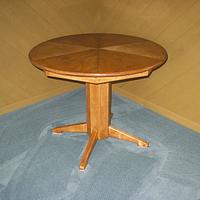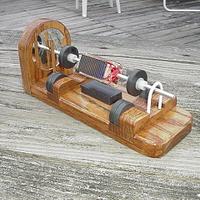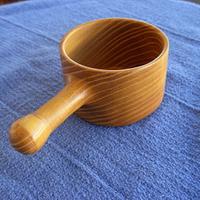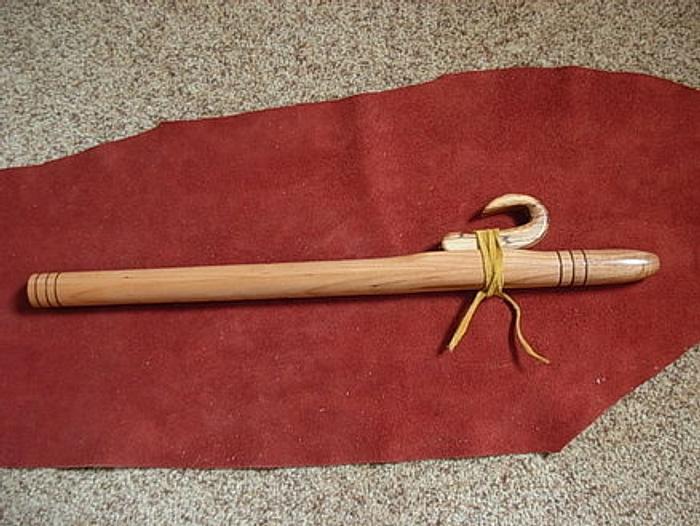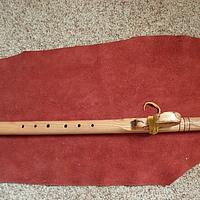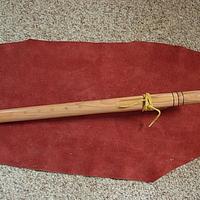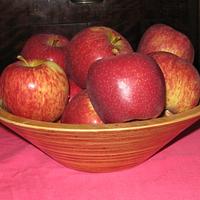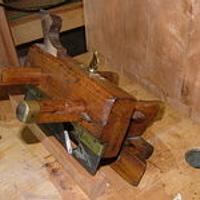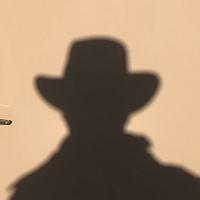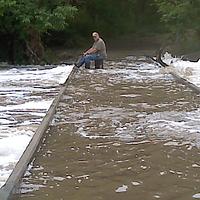Share your craft projects
Make new craft buddies
Ask craft questions
Blog your craft journey

Jim Jakosh
2830 posts
and
48 followers
in about 3 years
in about 3 years
More from Jim Jakosh
Native American Flute
This is a prototype on which I learned a whole lot about flutes. It is made from two long pieces of Cedar that were routed out to create the center opening. I used a plug turned from an old broom handle and glued it inside to create the two air chambers. After turning it, I added a mouth piece of Mesquite and turned it to match the diameter of the flute. The bird on top is made from spalted Beech. It is finished with shellac inside and clear matte spray on the outside.
I added the bottom shot at the end to show that this is kind of a Frankenstein flute. The bottom was originally the top. I started with some plans I pulled from the net that were pages on flute building from 1945. I liked them because they had dimensions but I could not get it to play any sound when I clamped the halves together so I plugged all the original holes and used the bottom for the top.
I found another site with flute facts and dimensions from John Stillwell. That is where I got the idea for the bird. I wanted to find how Bill Hayes from Pioneer Craft House in Salt Lake City made flutes when my friend Mike Wygmans ( a great instrument builder) loaned me a DVD for flute building and it was by Bill Hayes This was the best piece of information on flutes I have ever seen. It had a complete chart of tuning, but most of all it described the steps in the process so you did not get ahead of your self like I originally did.
I cannot play my flute does as well as I like. I have these overtones that take away from the sound of it and I can't seem to tune them out. This tuning business is a real art!! I called in to Bill and he called back and we talked for half an hour on what I can to do eliminate the over tones and he told me of the things he found that they are incorporating into their flutes they now build.
It was a lost cause to get it to play F#. I tuned to that with the the Snark tuner on the end of the flute for this initial tuning by vibration and cutting to length. That plugged the air hole and changed the tone a bit and now the flute is about 1/2" too short from all the dimensions I see on other F# flutes. I found this out by playing it into a mike with a tuner on a laptop which gave the true notes. It plays G flat with all the holes closed so I made it a G flute and opened all the holes to make the right notes .I took it to the flute festival and the Casa Grande Ruins and I had two of the local native Americans play it and it sounded really good in the hands of good musicians like that. They were surprised that I made it from scratch....Cheers, Jim
I added the bottom shot at the end to show that this is kind of a Frankenstein flute. The bottom was originally the top. I started with some plans I pulled from the net that were pages on flute building from 1945. I liked them because they had dimensions but I could not get it to play any sound when I clamped the halves together so I plugged all the original holes and used the bottom for the top.
I found another site with flute facts and dimensions from John Stillwell. That is where I got the idea for the bird. I wanted to find how Bill Hayes from Pioneer Craft House in Salt Lake City made flutes when my friend Mike Wygmans ( a great instrument builder) loaned me a DVD for flute building and it was by Bill Hayes This was the best piece of information on flutes I have ever seen. It had a complete chart of tuning, but most of all it described the steps in the process so you did not get ahead of your self like I originally did.
I cannot play my flute does as well as I like. I have these overtones that take away from the sound of it and I can't seem to tune them out. This tuning business is a real art!! I called in to Bill and he called back and we talked for half an hour on what I can to do eliminate the over tones and he told me of the things he found that they are incorporating into their flutes they now build.
It was a lost cause to get it to play F#. I tuned to that with the the Snark tuner on the end of the flute for this initial tuning by vibration and cutting to length. That plugged the air hole and changed the tone a bit and now the flute is about 1/2" too short from all the dimensions I see on other F# flutes. I found this out by playing it into a mike with a tuner on a laptop which gave the true notes. It plays G flat with all the holes closed so I made it a G flute and opened all the holes to make the right notes .I took it to the flute festival and the Casa Grande Ruins and I had two of the local native Americans play it and it sounded really good in the hands of good musicians like that. They were surprised that I made it from scratch....Cheers, Jim
Cheers, Jim ........................ Variety is the spice of life...............Learn something new every day
12 Comments
Jim,
Do you play the Flute?
I have never played them myself. But my Brother was in a Fife Band at school. I think the kids marched into school each morning to the tune of the Fife Band.
I was interested to see that Native Americans play Flutes. I didn't know that.
Great project Jim.
Regards......Cliff.
Do you play the Flute?
I have never played them myself. But my Brother was in a Fife Band at school. I think the kids marched into school each morning to the tune of the Fife Band.
I was interested to see that Native Americans play Flutes. I didn't know that.
Great project Jim.
Regards......Cliff.
Dandy flute looked good, Jim.
-- Soli Deo gloria! ( To God alone be the Glory)
Really good looking flute. Interesting build and how you came to do it.
Old Osage friend played a flute. Loved it.
He had a "story" of how the Osage and other tribes got the hole down the center of the flute. I think it was just a story to amuse and tease us kids. Flute was made from a piece of wood with pith in the middle where the hole was to be. As much as possible was dug out and then a wood eating worm was placed in the hole followed by a hot ember. The worm would then chew to get away from the heat of the ember The pith being softer was where the worm chewed. Had to keep the worm and the ember apart but close enough that the worm chose to go with the pith and not out the side.
Like the "story" but felt it was just that. My old Osage friend never would admit it was just a myth.
Your method has more favorable results.
Old Osage friend played a flute. Loved it.
He had a "story" of how the Osage and other tribes got the hole down the center of the flute. I think it was just a story to amuse and tease us kids. Flute was made from a piece of wood with pith in the middle where the hole was to be. As much as possible was dug out and then a wood eating worm was placed in the hole followed by a hot ember. The worm would then chew to get away from the heat of the ember The pith being softer was where the worm chewed. Had to keep the worm and the ember apart but close enough that the worm chose to go with the pith and not out the side.
Like the "story" but felt it was just that. My old Osage friend never would admit it was just a myth.
Your method has more favorable results.
Ron
Cool Jim, I can see where the tuning of a musical instrument would be a difficult task.
Main Street to the Mountains
Interesting project!
Ron, sounds like the torture where a rat is placed on ones belly and covered with a metal dish. Apply heat to the dish and the rat will chew through the "softer" material to get away (ouch!)
Nice flute Jim! Could get the vermin to follow you around and lead then away.
Nice flute Jim! Could get the vermin to follow you around and lead then away.
Sounds like a great learning experience, Jim!
May you have the day you deserve!
Thank you all for the nice comments. This is another case of I'll try anything once. I watched several videos and never could get it to make the beautiful sounds that the local Indians played on it. I think I might be blowing too hard into it. It has a slow air chamber just in front of the mouthpiece and that has to be SLOW.
Cliff, I can't play any instrument..I wish I could. I just play the wood lathe, the metal lathe and the stick welder .
Cheers,Jim
Cliff, I can't play any instrument..I wish I could. I just play the wood lathe, the metal lathe and the stick welder .
Cheers,Jim
Cheers, Jim ........................ Variety is the spice of life...............Learn something new every day
vERY NICE WAY TO PRESERVE CULTURE...
...woodicted
I like the old school look to it. Great job. Mike
Thanks Ivan and Mike............Cheers, Jim
Cheers, Jim ........................ Variety is the spice of life...............Learn something new every day









